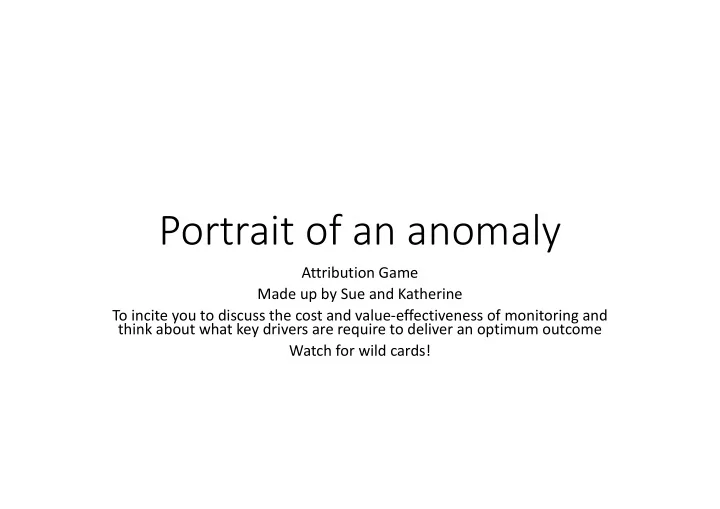

Portrait of an anomaly Attribution Game Made up by Sue and Katherine To incite you to discuss the cost and value ‐ effectiveness of monitoring and think about what key drivers are require to deliver an optimum outcome Watch for wild cards!
Po Portrait of of an an anomaly anomaly sequ sequence of of even events • Make four groups (with members of diverse skill) and draw your color 7 min explain and organize) • Pick up “Data from site selection and permitting” 7 min read materials and discuss • Pick up “Monitoring location options“ • Round one – select “characterization baseline monitoring cards” 14 min discuss, select and read back of cards (make them move though this step Buy, pick up and turn over quickly 14 min discuss, select and read back of cards (make them move though this step • Round 2 – 10 years of monitoring cards quickly • Buy, pick up and turn over 14 Min Develop an attribution strategy any anomalies • Round 3 hand out “all seeing view” 7 min read materials and discuss prepare report on • poster board • Conclusion each group present their project history. Outcomes, 21 min present 4 min/ group success and recommendations
Data from site selection and permitting Former gas producers, one of a dozen P&A with records Meters CO 2 injection well Water Water sea level datum well well Water wells Water table Sea level Aquifer A Aquifer B Wildcat, ca 1940 P&A with records. One of a dozen Mostly low permeability Zone C Depleted gas ‐ ‐ 1000 productive sand Map view Mostly low permeability source rock Zone D Target saline formation Modeled 25 year CO 2 plume extent ‐ 2000 Deep zone, no production 0 1 2 3 km
Monitoring location options 3 ‐ D Seismic Survey Meters 400 Soil gas stations sea level datum 22 Ground water wells Water table Sea level 4 Above ‐ zone monitoring Aquifer A A wells B Aquifer B Wildcat, ca 1940 P&A 4 In ‐ zone monitoring wells with records. One of a dozen Mostly low permeability 3 ‐ D Seismic Survey over whole A area ‐ 1000 Zone C Depleted gas ‐ productive Location key C sand Soil gas over whole area Mostly low permeability source rock D Map view Target saline formation Modeled 30 year CO 2 plume extent ‐ 2000 Deep zone, no production 0 1 2 3 km
Conclusions from Sue and Katherine • Attribution of anomaly (incident or allegation) is hard, prepare for it. • Smarter monitoring design would help. E.g. attention to groundwater system dynamics, discharge points; well in top of depleted gas field structure, details of heterogeneity in reservoir C. • Smarter monitoring design does not mean more monitoring. Cost and effort should be optimized without sacrificing accuracy. • Models of expected and unexpected material impact events (ALPMI) would be helpful, it is very hard to interpret data without a model. • We think the leakage events shown are not really realistic – leakage to surface would be retarded more. Give us more monitoring rounds to detect it.
baseline Ten years Injection Zone pressure and chemistry plots Headspace Gas Chemistry Pressure 100 Wellhead pressure in D (Bar) 19 9 Downhole pressure in D (Mpa) ‐ 20 this is early 100000 18 8 80 del 13 C CO 2 (PDB) breakthrough of ‐ 40 17 7 Anthro CO 2 in 10000 C1/(C2+C3) 60 CH 4 /CO 2 6 16 ‐ 60 these two wells. 1000 40 15 5 ‐‐ 80 14 4 20 100 ‐ 100 13 3 0 Aqueous Chemistry 10 1 12 2 100 1 1 ‐ 1 0 1 2 3 4 5 6 7 8 9 10 7.5 ‐ 1 0 1 2 3 4 5 6 7 8 9 10 80 Time (years) 2 Time (years) 7 60 TDS g/L 0 Monitoring well D ‐ 1 del 18 O (permil) 6.5 pH 40 ‐ 2 Monitoring well D ‐ 2 5 20 ‐ 4 5.5 0 Monitoring well D ‐ 3 ‐ 8 4 Monitoring well D ‐ 4 ‐ 12 ‐ 1 0 1 2 3 4 5 6 7 8 9 10 Time (years)
baseline Ten years depleted gas reservoir C pressure and chemistry plots Headspace Gas Chemistry Pressure 100 Wellhead pressure in C (Bar) 9 9 Downhole pressure in C (Mpa) ‐ 20 this is early 100000 8 8 80 del 13 C CH 4 (PDB) accumulation of ‐ 40 7 7 small methane cap 10000 C1/(C2+C3) 60 CH 4 /CO 2 6 6 ‐ 60 in these two wells. 1000 40 5 5 ‐‐ 80 4 4 20 100 ‐ 100 3 3 0 Aqueous Chemistry 10 1 2 2 100 1 1 ‐ 1 0 1 2 3 4 5 6 7 8 9 10 7.5 ‐ 1 0 1 2 3 4 5 6 7 8 9 10 80 Time (years) 2 Time (years) 7 60 TDS g/L 0 Monitoring well C ‐ 1 del 18 O (permil) 6.5 pH 40 ‐ 2 Monitoring well C ‐ 2 5 20 ‐ 4 5.5 0 Monitoring well C ‐ 3 ‐ 8 4 Monitoring well C ‐ 4 ‐ 12 ‐ 1 0 1 2 3 4 5 6 7 8 9 10 Time (years)
Recommend
More recommend